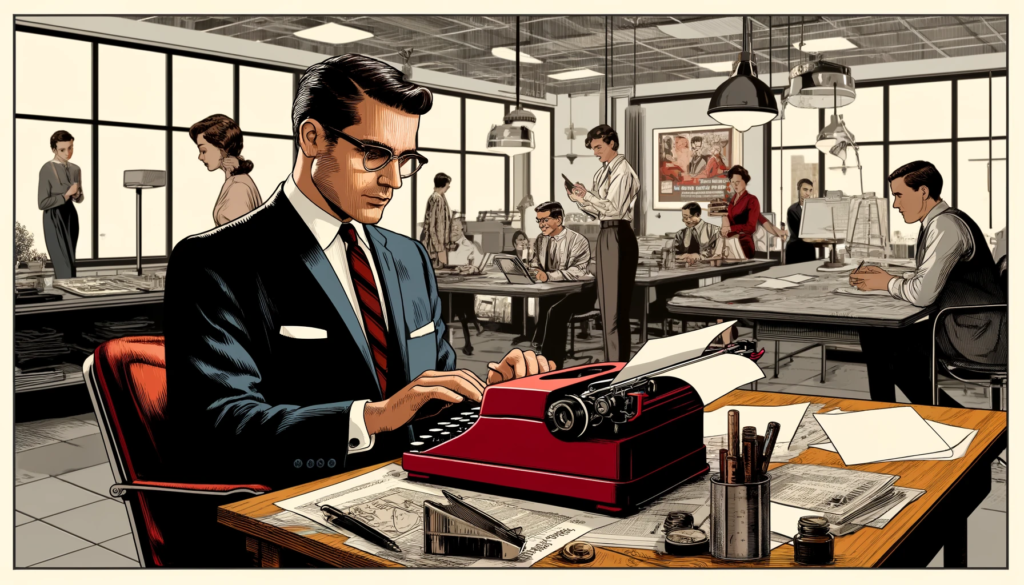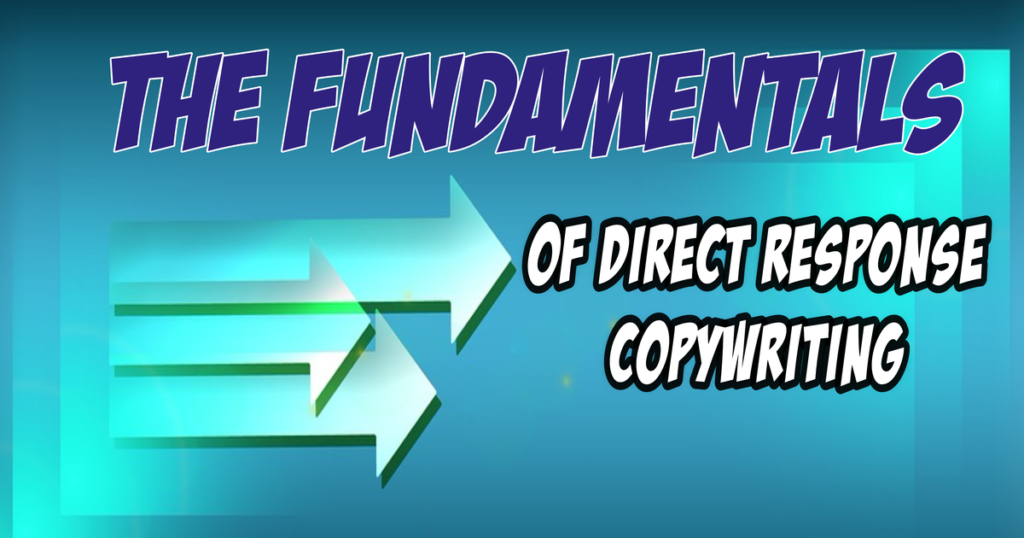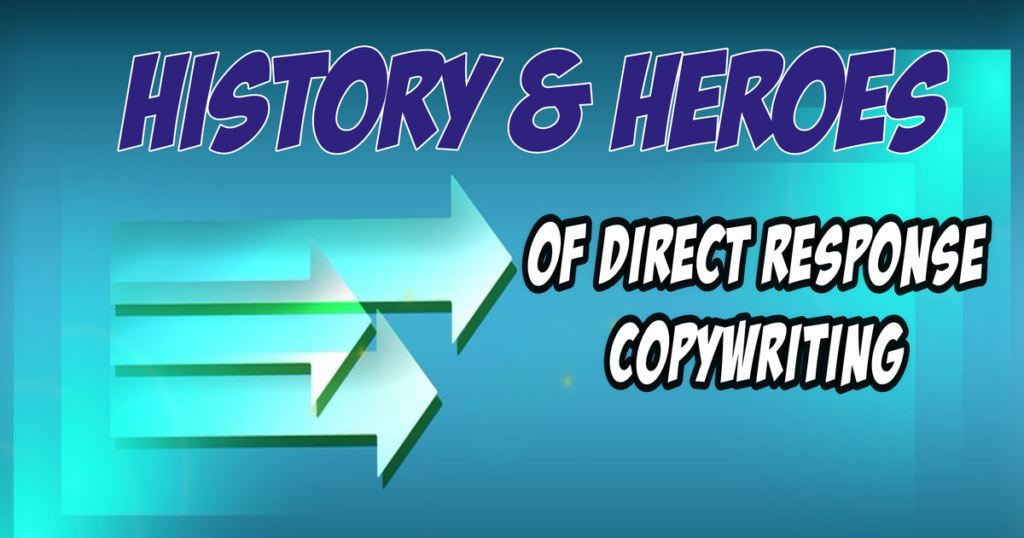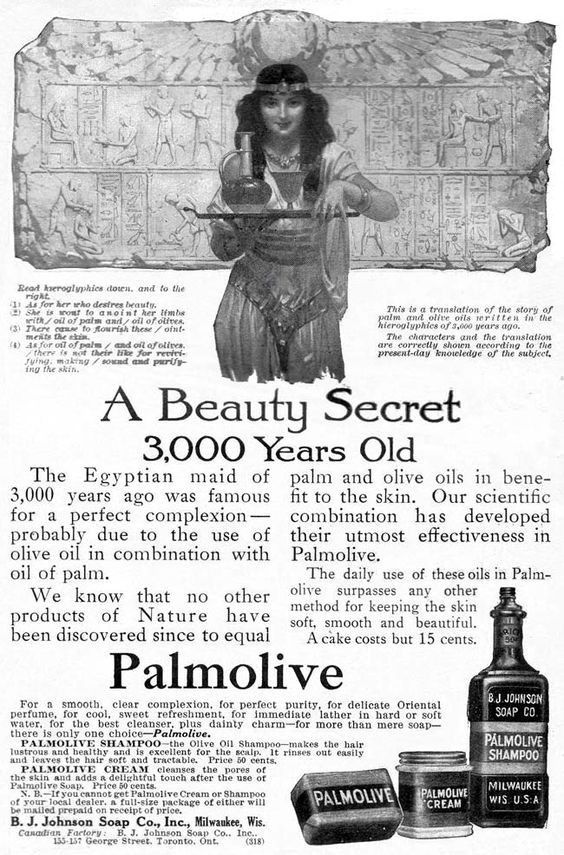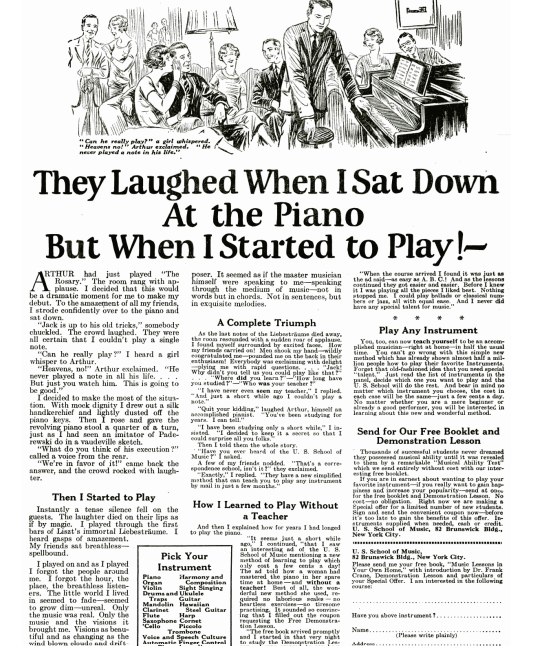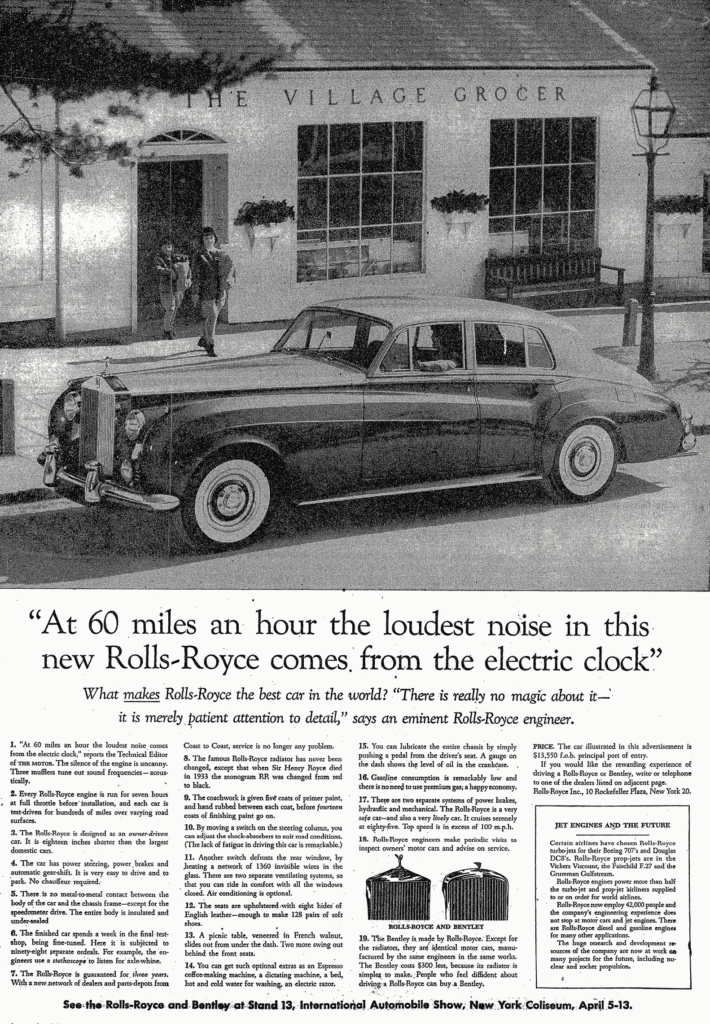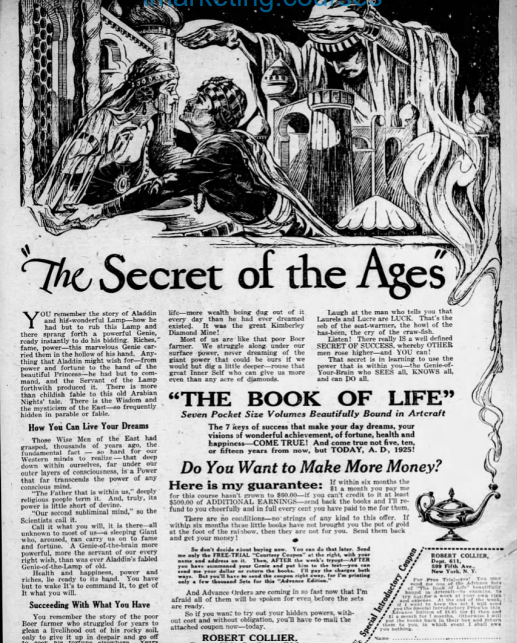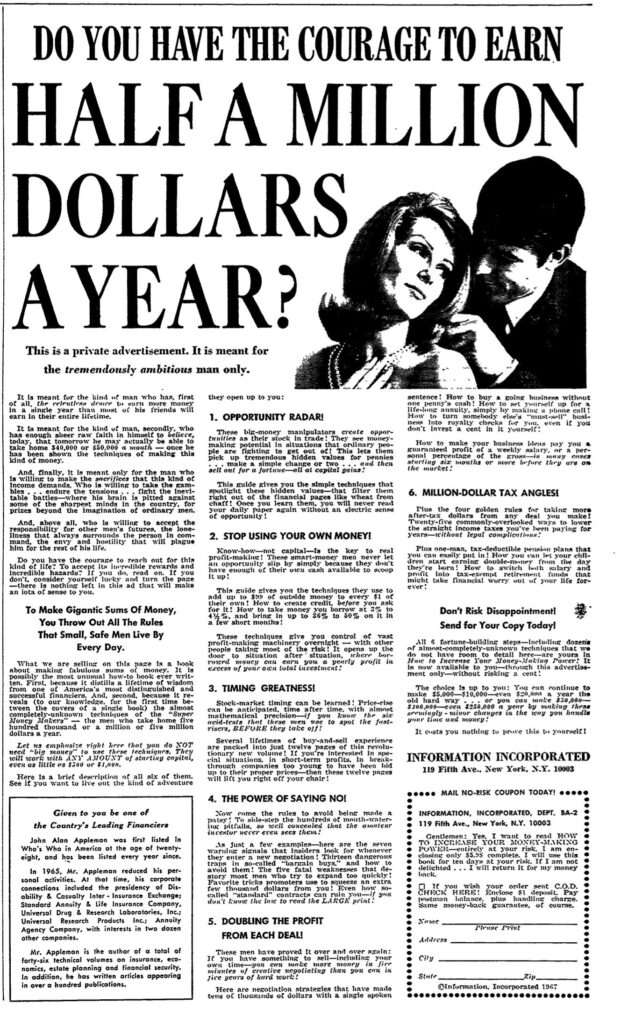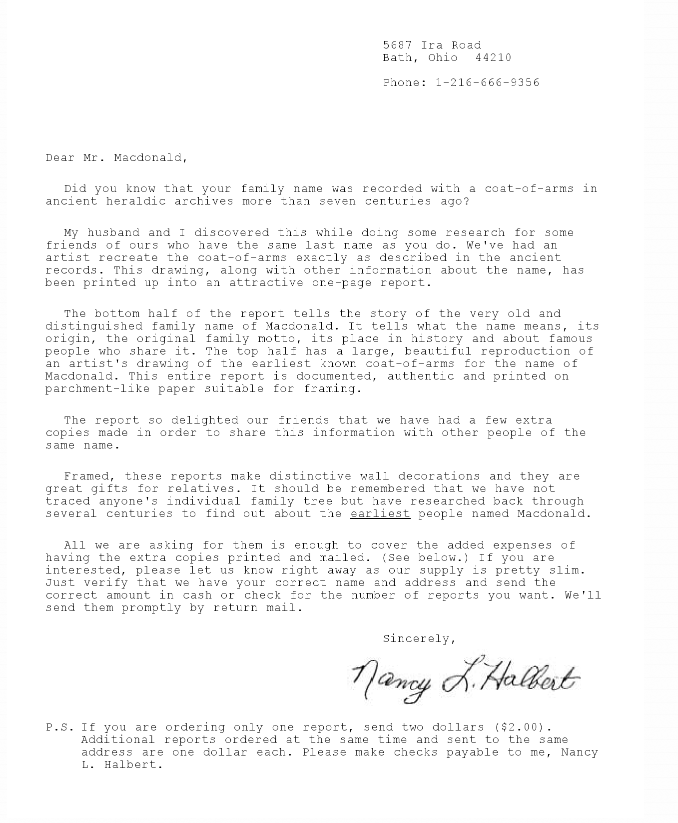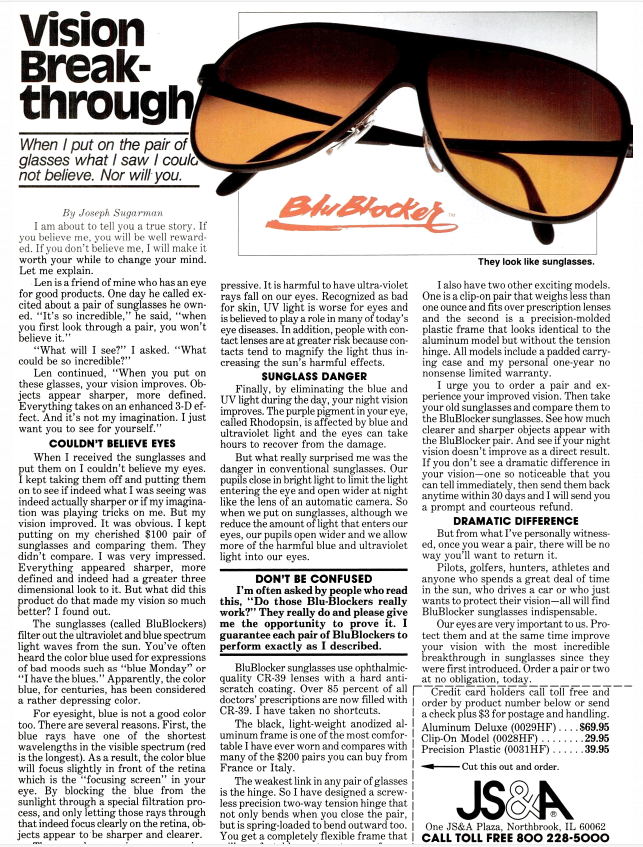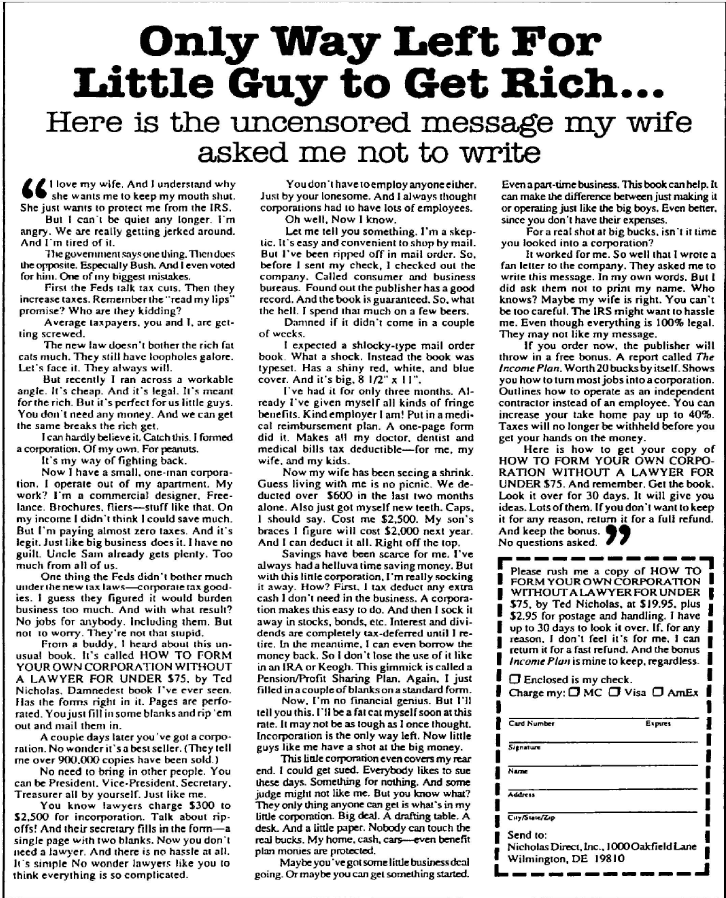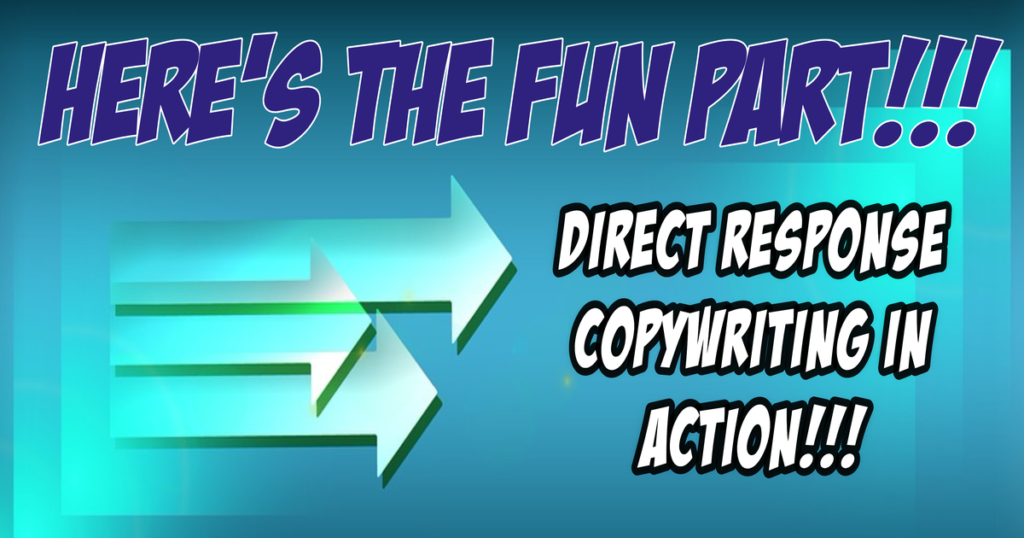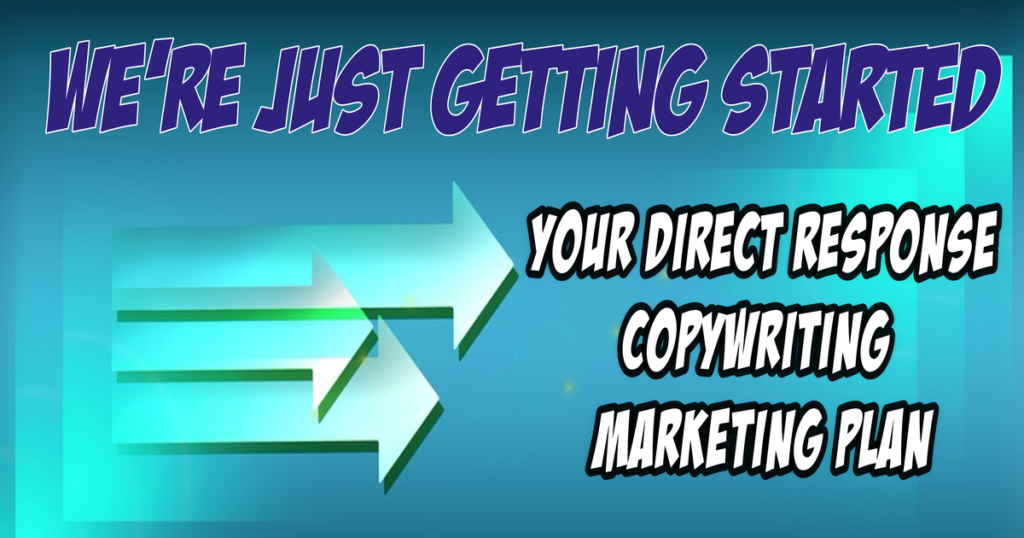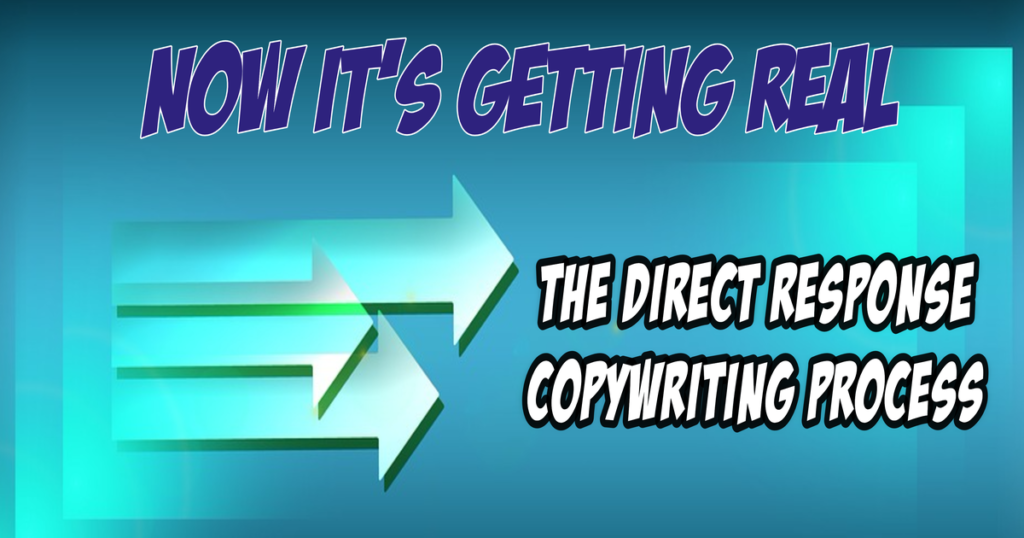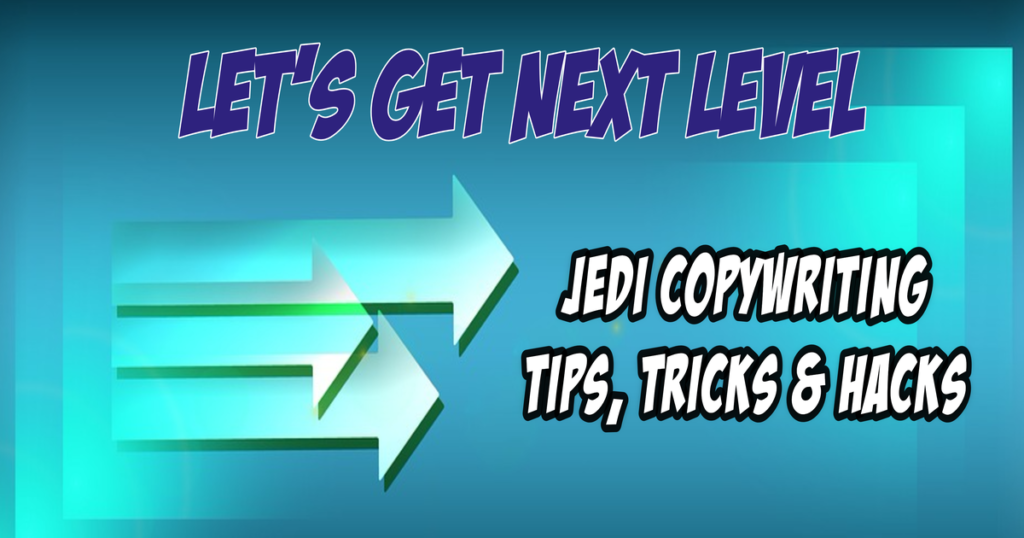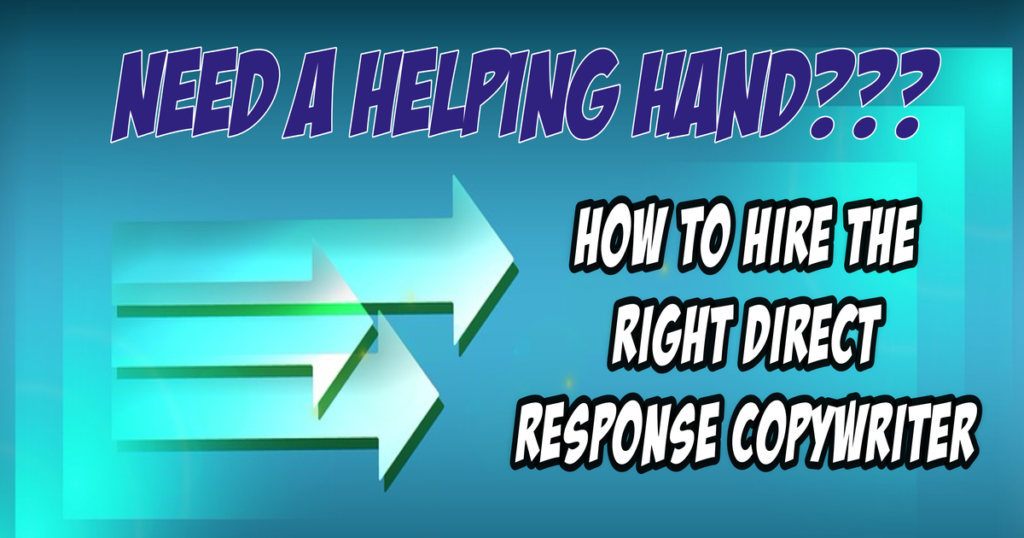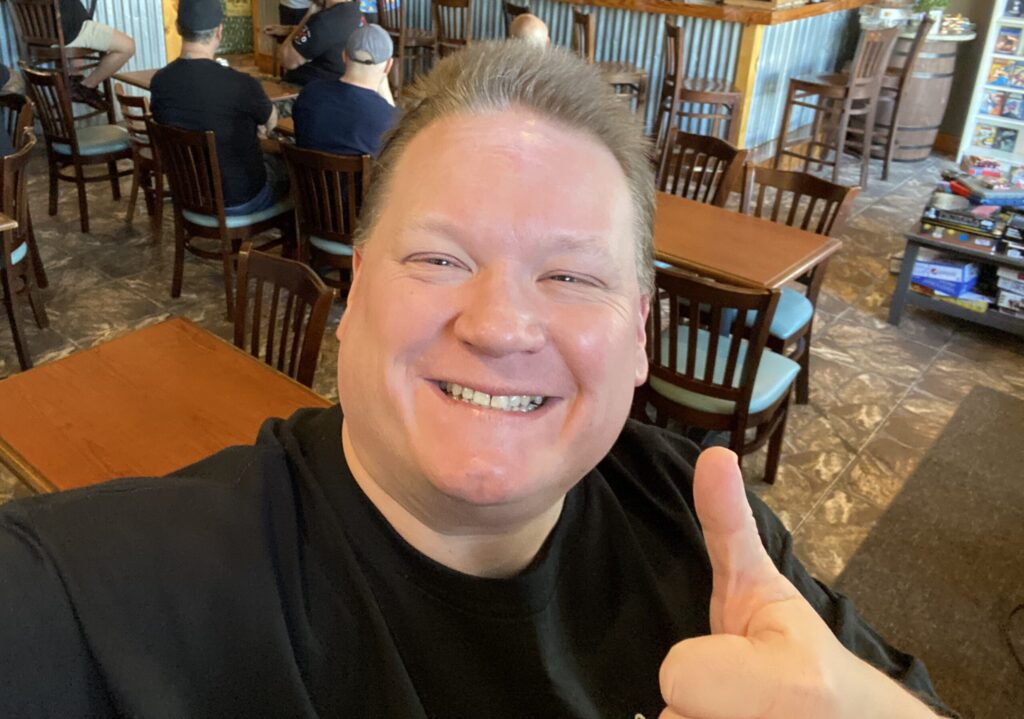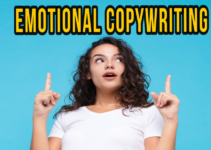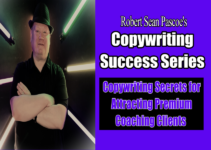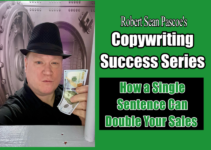How I Went from Star Salesman to Freelance Copywriter
The Roots of Direct Response Copywriting
Direct response copywriting isn’t a new trick in the marketer’s book—it’s been around for more than a century, arguably since the inception of mail-order advertising. Its essence has always been the same: craft a message so compelling that the reader feels an immediate urge to act—whether it’s to order a product, sign up for a newsletter, or make a phone call.
In the early days, direct response copywriting was the backbone of catalog shopping. Sellers had to rely solely on the power of their words to paint a picture of their product that was vivid enough to entice customers from afar. This was the era before television and digital media, where every word counted and space in print was precious.
The aim was straightforward: get a measurable response from the advertisement, often tracked with a coupon code or a return mail card. This method allowed businesses to see exactly how effective their copy was, and thus, direct response copywriting became a critical element of successful advertising strategies.
The Pioneers of Direct Response Copywriting
Direct response copywriting goes beyond just selling—it’s about tapping into what people really want and need.
The masters of this art, like Claude Hopkins, John Caples, and David Ogilvy, knew this well. They didn’t just write words; they crafted messages that struck a chord and moved people to action.
These pioneers were like magicians of the mind, turning simple curiosity into a powerful urge to act. They knew how to make readers not just want but need what they were selling.
Their work is a masterclass in the art of persuasion. They showed us that to sell a dream, you have to dream it first. You have to know the lives of your customers to offer them a new lifestyle. They didn’t just understand their audience’s problems—they felt them. They dove into the heart of what drives people, and their teachings are just as powerful today as ever.
This section is a salute to their brilliance. It’s a chance for us to weave their timeless tactics into our modern strategies.
Let’s explore their insights and discover how their words still resonate in the world of copywriting today.
Claude Hopkins – The Father of Scientific Advertising
Claude Hopkins was a trailblazer, insisting that good copy should be based on a fundamental understanding of the psychology of the buyer, meticulous research, and a relentless focus on results.
He approached each campaign with the mindset of a scientist.
This included conducting experiments and gathering data to support his advertising decisions. It was unheard of at the time and is a practice that modern marketers continue to rely on.
Hopkins’s methods went beyond mere trial and error. He sought to understand why certain techniques worked, diving deep into consumer behavior and preferences.
This deep understanding allowed him to craft messages that resonated on a personal level with potential buyers. Hopkins was a master at finding the inherent drama in a product and presenting it in a way that was both factual and persuasive.
Moreover, Hopkins advocated for clarity in advertising. He believed that clear and direct messages trumped the overly artistic or vague. He stressed that the purpose of language in advertising was not to entertain or to be clever, but to sell.
His own writing was characterized by straightforward, conversational language that could be easily understood.
Claude Hopkins’s work is not just a lesson in advertising but a reminder of the power of simplicity, the importance of data, and the effectiveness of consumer psychology. His legacy is a blueprint for creating advertising that sells, and his principles are just as relevant now as then.
Claude Hopkin’s Palmolive Ad
John Caples – The Master of Headlines
David Ogilvy – The King of Madison Avenue
David Ogilvy was the titan of turning smart research into captivating ads. He dug deep to know the audience, crafting messages that didn’t just talk at them but spoke to them. His copy was a mix of charm and facts, making products more than just items to buy—they were pieces of a dream.
He had a clear rule: make it fascinating, make it truthful, and make it something people aspire to. His Rolls-Royce ads didn’t just show a car—they presented a slice of the high life.
Ogilvy was all about the brand’s voice too. He believed that a brand should sound like a friend—distinct and reliable, no matter where you heard it. His belief was that a good ad isn’t just a pitch; it’s a conversation, and a lasting one at that.
His work wasn’t just words on paper; it was a blueprint for building trust with every line. Even now, Ogilvy’s methods are like a master class in copywriting, blending knowledge, emotion, and a spark of humor—a recipe for timeless advertising.
David Ogilvy’s Rolls Royce Ad
Robert Collier – The Psychological Connector
Robert Collier was a virtuoso of emotional resonance in copywriting. He understood the power of personal connection and used it to draw readers into a narrative that felt like it was written just for them. His letters didn’t just communicate; they whispered into the readers’ hearts, coaxing desires and dreams into the open.
Collier’s genius was in his use of serial storytelling to keep readers engaged over time. He’d start a conversation and gently guide them through a series of letters, each one a stepping stone towards the ultimate goal: the sale. This strategy demonstrated his deep appreciation for the reader’s journey from curiosity to commitment.
He was also a proponent of ‘selling without selling,’ often making his sales pitch feel like a natural extension of the helpful advice or insights he provided. By the time readers reached the end of his letters, the purchase felt like their own idea—a testament to Collier’s skill at understanding and navigating the psychology of persuasion.
Robert Collier’s “The Secret of the Ages” Ad
Eugene Schwartz – The Grand Strategist
Eugene Schwartz stood at the intersection of marketing psychology and copywriting, crafting messages that met readers exactly where they were in their awareness journey. His approach was strategic, always aiming to guide the reader from a state of problem-awareness to solution-desire.
Schwartz didn’t just communicate; he educated. His writing served to gradually elevate the reader’s understanding, taking them from a place of curiosity to conviction. He knew that an informed reader was more likely to become an engaged buyer, and his copy was a masterclass in leading someone down that path.
Notoriously meticulous about headlines, Schwartz believed they were the gatekeepers of attention. He would labor over every word, each iteration a step closer to that perfect combination that resonated with the reader’s deepest needs and aspirations.
His methodical approach to copywriting was about more than just selling products; it was about initiating a conversation that could change perceptions and, ultimately, behavior. This is why his lessons continue to echo through the halls of marketing and copywriting, inspiring new generations to weave strategy into storytelling.
Eugene Schwartz’s “Do You Have the Courage Ad”
The Legends of Modern Direct Response Copywriting
In the dynamic realm of copywriting, some names have become almost legendary, etching their wisdom into the very DNA of marketing. Gary Halbert’s unorthodox methods shook the foundations of what was considered ‘good’ copy, turning the rules on their head to spectacular effect. His letters didn’t just speak to people; they seemed to reach out from the page and grab readers by the collar, demanding attention.
Ted Nicholas, with a meticulous eye for detail, showed how even the smallest tweak could turn a trickle of response into a flood. He taught us that in the economy of words, every syllable must earn its keep, each line must lead inexorably to the next.
And then there’s Joe Sugarman, who blended the art of storytelling with the precision of direct response copy. His ads weren’t mere promotions; they were compelling tales that led the reader on an irresistible journey from curiosity to purchase.
These titans of copywriting didn’t just write; they inspired movements, they built empires with nothing but words and wits. Their strategies, stories, and successes continue to instruct and inspire, proving that the pen isn’t just mightier than the sword—it’s also the key to unlocking hearts, minds, and wallets.
Gary Halbert – The Prince of Print
Gary Halbert’s name rings through the halls of advertising as a maestro of the direct mail world. His letters were more than mere messages; they were conversations across the kitchen table, making every reader feel as if Gary himself was speaking directly to them.
“The Coat of Arms” letter stands as a testament to his prowess, a missive that didn’t just deliver information but wove a narrative that made the reader the protagonist of their own story.
Halbert’s approach was disarmingly simple: he connected with readers on a personal level, tapping into their desires, their family pride, and their curiosity. He understood that to get someone to open their wallet, you first had to open a dialogue with their heart.
The legacy of Gary Halbert’s “The Coat of Arms” campaign is not just in the volume of responses it generated, but in the way it reshaped the approach to direct response copywriting. He showed that the key to conversion lay not in the hard sell, but in the soft touch — the human connection that turns prospects into customers and customers into evangelists.
This approach, focusing on the individual rather than the masses, set a precedent for personalized marketing and remains a cornerstone of effective copywriting strategies today. His techniques continue to influence marketers across the globe, proving that great copywriting is timeless.
Gary Halbert’s Coat of Arms – The Most Successful Direct Mail Letter of All Time
Joe Sugarman – The Mail Order Maverick
Joe Sugarman’s approach to copywriting was groundbreaking, not only for its effectiveness but also for its charisma. He was not just selling a product; he was selling an experience, a story that the customer could buy into.
Sugarman understood that purchasing decisions are often driven by emotions and justified by logic, so he made it his mission to trigger an emotional response first and foremost.
His writing would often start with a hook that captivated the reader, drawing them into a narrative that was both engaging and informative. He painted vivid pictures with his words, using humor, curiosity, and an intimate tone that made each reader feel as though Sugarman was speaking directly to them.
This personal touch was a hallmark of his style, making each advertisement seem less like a sales pitch and more like a recommendation from a trusted friend.
Sugarman was also adept at foreseeing customer objections and addressing them within the narrative of his copy. By the time the reader reached the call to action, any doubts had typically been assuaged.
His method of selling was subtle yet powerful, weaving features and benefits into the fabric of a larger, more compelling story.
The BluBlocker sunglasses campaign was a testament to his innovative approach. Sugarman didn’t just list the features of the sunglasses; he explained their benefits in a way that was relatable and easy to understand.
He introduced the product with an intriguing story or fact, making the reader feel enlightened and intrigued. Then, he skillfully guided them down a path that led to the realization that they needed, or even deserved, this product in their life.
Ted Nicholas – The King of Print
Ted Nicholas earned his moniker as “The King of Print” through his meticulous craft and unyielding commitment to excellence in copywriting. His approach went beyond the mere construction of persuasive sentences.
It was about the alchemy of words, creating a formula so potent that it seemed irresistible to the reader.
Nicholas believed in the power of specificity and precision. He was known for the exhaustive testing of his work, ensuring that each element of the copy was honed to perfection and resonated with the target audience.
His understanding of human psychology was evident in the way he positioned products as not just purchases, but as investments in one’s happiness, success, or well-being. By doing so, Nicholas was able to elevate the perceived value of the products he was selling, making them seem indispensable.
His ads were more than a showcase of features; they were a narrative of the benefits, painted vividly through the use of testimonials, detailed descriptions, and a deep understanding of his reader’s deepest aspirations and fears.
The effectiveness of Nicholas’s copy was in its clarity and the promise of ease.
In the case of his ad for “How to Form Your Own Corporation Without a Lawyer for Under $75,” he tapped into the entrepreneurial spirit, addressing a common pain point with a solution that was not only affordable but also accessible. He broke down complex legal procedures into a simple, step-by-step guide, empowering the average person with the tools to achieve their business dreams.
A Classic Ted Nicholas Print Ad
Conclusion to the History and Heroes of Direct Response Copywriting
Our journey through the annals of direct response copywriting wraps up with a profound sense of reverence for the masters of the craft. From Claude Hopkins’ meticulous methods to Robert Collier’s emotional resonance, each pioneer etched their mark into the bedrock of persuasive writing.
These architects of persuasion—Hopkins, Caples, Ogilvy, Schwartz, and their illustrious ilk—didn’t just put pen to paper; they struck chords in the hearts of readers, transforming curiosity into action with unparalleled skill.
As we absorb their enduring strategies, we understand that the essence of direct response remains constant, even as platforms and trends shift. These maestros didn’t just communicate; they compelled, with a mastery that continues to shape how we engage and sell.
Their legacies are not confined to the past; they pulse through every line we compose today. Their discoveries, innovations, and even their rebellions against convention, are the bedrock upon which modern copywriting stands. They remind us that whether we’re typing a tweet, scripting a webinar, or drafting a whitepaper, we’re part of a grand continuum of storytellers and salespeople.
Paying tribute to their achievements, we don’t just reminisce—we empower ourselves for the future. With each word we write and each campaign we launch, we draw from their well of wisdom, aiming to connect, convince, and convert.
The story of direct response copywriting is a saga of triumphs and lessons learned, and as its torchbearers, we continue to illuminate the path of commerce with the written word. Let’s carry on this legacy, upholding the standards of the greats and reaching new heights in the pursuit of persuasive excellence.
Direct Response Copywriting in Action
Have you ever wondered how just a few words can make people click, call, or buy right away? That’s the power of direct response copywriting. It’s not just putting words together. It’s about making a message so strong that people just have to act now.
Before any writing starts, we’ve got to prep. Think of it like getting ready for a big game. The best campaigns are like well-cooked meals—they need the right ingredients. Knowing who you’re talking to, making your deal sweet, and getting your message just right are all key. It’s like building a house. First, you need a solid plan.
We’re about to get our hands dirty with the details. From setting up all you need for a killer copy, planning your winning strategy, to the actual writing—we’ll go through it all, one by one. It’s like a guided tour through the world of copy that sells.
Get set for a deep dive into how to write stuff that sells. We’ll cover everything from boosting your Facebook ads, making landing pages that hook people in, to crafting long sales pages that nobody can resist.
This is your master plan for making words that bring in the bucks.
Let’s jump in and make your copy the best sales tool you’ve got.
Before You Start Writing
Before you write a single word, you’ve got to know who you’re talking to. Think about it like this: You wouldn’t give the same gift to your grandma as you would to your best friend.
Everyone’s different, right? So, to sell something, you need to get who your audience is—what they want, what they need, what they dream about, and what bugs them.
Now, how do you figure this out? Start by looking at who buys your stuff. Are they busy moms? Gamers? People who love to cook? Then, think about their day. What’s tough for them? What would they love to make easier? What makes them happy?
This helps you see what they’re after.
Next, it’s time to do some detective work. You can look at surveys or check out online reviews. Social media is also a goldmine. What are people saying about stuff like yours? Are they thrilled or bummed out?
This info is like a secret clue to what they’re looking for.
Remember, the better you know your audience, the better you can chat with them through your copy. It’s like knowing just what to say to your friend to cheer them up. When you hit the right notes, people feel like you get them.
And when folks feel understood, they’re way more likely to buy from you. So, take the time to really dig into your audience’s world. It’s the first big step to making your copy do its magic.
Analyzing Your Product or Service
Let’s talk about what you’re selling. It could be a cool gadget, a helpful service, or even an awesome online course. Whatever it is, you gotta know it inside out. See, every product has got stuff it can do—those are features. And then there are the good things that come from those features—those are benefits.
Here’s how to break it down. First, list all the things your product can do. Like, maybe it’s a watch that can go underwater. That’s a feature. But what’s the benefit? It means swimmers can use it without worry. That’s what really matters to the person buying it.
Now, think about your customers. What are they looking for? If they’re swimmers, they’ll love that waterproof feature. But if they’re not, maybe they’ll care more about how cool the watch looks. That’s where you gotta match what your product does with what your audience wants.
Once you know this, you can talk about your product in a way that makes eyes light up. Don’t just say, “This watch can stay underwater for hours!” Say, “Swim all you want and still keep time with our waterproof watch!” See the difference? One tells them what it does; the other tells them why it’s awesome for them.
So, take a good look at what you’re selling. Turn those features into benefits that make your customers say, “Hey, I need that!”
When you do that right, you’re on your way to making a sale.
Ready to Put the Power of Killer Copywriting to Work for YOUR Business…
But Don’t Want to Do it Yourself?
As a direct response copywriter who specializes in writing hard hitting sales pages, landing pages, social media ads and emails for online businesses, I have the skills you need to get get results you deserve.
What I offer:
- ✅ Copy tailored to your audience’s needs
- ✅ Custom solutions for your unique brand
- ✅ Conversion-optimized content to drive results
Bridging the Gap
Imagine there’s a wide river between what people want and your product. Your job is to build a bridge so they can cross over easily. That’s what the ‘Big Idea’ is all about. It’s a powerful thought that hooks up what people need with what you’re selling.
So, how do you dream up this Big Idea? Start by thinking deep about what makes your product a star. Maybe it’s something it does that no other product can. Or maybe it makes life a whole lot easier in a way folks haven’t thought about. That’s your golden ticket.
Now, look at it from the side of the folks you’re selling to. What’s their big wish? Maybe they want to save time, or they want to look cool, or they need to fix something that’s bugging them. Your Big Idea should be like a lightbulb that pops up over their heads and makes them go, “Aha! That’s just what I need!”
Once you’ve got your Big Idea, it’s all about showing people how your product is the bridge to what they want. Like, if they’re tired of phones dying too fast, and your phone has a battery that lasts for days, then your Big Idea is all about freedom from chargers.
You’ve got to make it clear that your product is not just nice to have; it’s the thing that fills a gap they’ve been wanting to close. When you nail that, people won’t just want what you’re selling—they’ll feel like they’ve got to have it. That’s when you know you’ve built a bridge that’s strong and sure.
Crafting the Sales Message
Now you’ve got a Big Idea, it’s time to shape your sales message. This message is the heart of your campaign. It’s what you want to shout from the rooftops so everyone hears it loud and clear. Think about what mood you want to set. Should your words feel like a chat with a buddy, or more like a coach pumping you up? That’s the tone, and it’s got to match your Big Idea.
Let’s put your product in the spotlight. Say it’s a new kind of sneaker that’s super comfy. Your core message could be about walking on clouds. That’s the picture you want to paint in people’s minds. So, your tone could be dreamy and light, just like those clouds.
But don’t stop at just being dreamy. Mix in some real talk, like how these sneakers have special soles that keep your feet happy. That’s using logic to back up your dreamy message. And it works like magic.
Now, tap into feelings. Everyone loves feeling good, right? Use words that make them imagine that comfort. “Say goodbye to sore feet with our cloud-soft sneakers!” That’s how you get them to feel something. And when they feel, they’re more likely to hit that ‘buy’ button.
So, pick your message, set your tone, and mix dreams with real stuff. That’s how you’ll make a sales message that sticks.
Choosing the Right Campaign Materials
When you’re getting ready to sell something, think of it like planning a party. You need different things for different parts of the party, right? It’s the same with selling. You need different kinds of writing for different steps when you’re trying to make a sale. This is your sales funnel, and each part needs its own type of message.
First up, you need something that grabs attention. This could be a cool ad or a catchy social media post. Something that makes people look. Then, once they’re looking, you need a landing page that tells them more. This is like welcoming them into the party and showing them around.
Next, you’ve got your main event, the sales page. This is where you tell them all about what you’re selling and why it’s awesome. It’s like the big moment when the cake comes out at the party. And don’t forget the emails. They’re like the follow-up, making sure everyone had a good time and inviting them back.
You’ve also got to think about where your customers hang out. Are they scrolling through Facebook, watching YouTube, or reading blogs? You need different messages for each place. A blog post is longer and tells a story. A Facebook ad has to be short and snappy. YouTube might need something fun and visual.
So, plan your party—oops, I mean your sales funnel—right. Match your messages to each part of the sale and where your customers are. That way, you’ll have the right kind of writing to make people want what you’re selling, no matter where they find you.
Mapping Out the Campaign
Think of selling your product like a road trip. You’re the driver, and your customer is riding shotgun. You’ve gotta map out where you’re going so you don’t get lost. Each piece of writing in your campaign is a stop along the way. Every stop has its job in getting your customer to the final destination—the sale.
First, you drop a postcard in the mail. That’s your ad or social media post. It’s the invite to start the journey. This stop’s goal? Get attention and make ’em curious.
Next is the welcome sign to your town, the landing page. Here, you tell your customer, “You’re gonna like it here.” The job of this stop is to get them interested, so they stay for the whole trip. You want them to click that button and say, “Tell me more.”
The big billboard, that’s your sales page. It’s the main attraction, showing off all the cool things they can do if they buy what you’re selling. This stop needs to convince them to open their wallets.
Don’t forget the souvenirs, the follow-up emails. They remind your customer about the great time they’re having. These make sure they don’t forget to grab that thing they wanted—your product.
For each stop, you need a goal. How many people do you want to get curious? Click? Buy? And you need a way to keep score. That’s your metrics, like clicks, likes, and sales. They tell you if you’re on the right path or if you need to reroute. Plan your trip right, and you’ll have a car full of happy customers ready to buy.
Boost Your Brand’s Voice with Expert Copywriting
Discover the power of words and make your message resonate.
What I offer:
- ✅ Adaptive copy that speaks to your audience’s heart
- ✅ Brand-focused solutions for authentic engagement
- ✅ Strategic content that amplifies your reach
Resource Allocation
Alright, let’s talk about what you need for your campaign, like time and money. Think about it like planning a big party. You gotta know how much you can spend on snacks, decorations, and maybe a DJ.
First up, money. You need some cash for writing all that cool stuff that’s gonna sell your product. That’s your copywriting cost. Then, you need your ads to look good, right? That’s where design comes in. Don’t forget you gotta pay to show your ads to people, like buying a spot on a billboard, but on the internet. That’s your advertising cost.
Now, let’s talk time. You can’t just throw all this together in one night. You need to plan when to write your ads, make your web pages, and send those emails. And you gotta do it at just the right time, so people see it when they’re ready to buy.
So, grab a calendar. Mark down all the important dates, like big shopping days or special events that match what you’re selling. Plan to get your ads out before these days so people can think about buying your stuff.
Remember, you don’t want to run out of money before you’re done, and you don’t want to be scrambling at the last minute. Spread out your spending and give yourself enough time to make everything awesome. That way, when it’s go-time, you’re all set to sell.
Compliance and Testing
Before your ads hit the road, make sure they follow the rules. Like a car needs to pass inspection, your ads need to check off on some big no-nos. You can’t just say anything you want; there are advertising laws. And each place you put your ads, like Facebook or Google, has its own rulebook. You’ve got to play by these rules, or they’ll kick your ads off the road.
Now, about testing. Think of it like trying on shoes before you buy them. You want to make sure they fit right and look good. For your ads, this means testing which words or pictures get more people clicking. This is called A/B testing. You make two versions of your ad that are almost the same but change one thing, like the headline. Then you see which one people like better.
Doing this testing step is super important. It helps you figure out what works best. When you know what gets more clicks, you can use that to make even better ads. And better ads mean more people buying what you’re selling.
So, test your ads, follow the rules, and get ready to sell.
Writing for Facebook Ads
1. Understanding the Platform’s Audience
Think of Facebook as the neighborhood block party. It’s buzzing, lively, and everyone’s there for a good time. When you’re writing for this crowd, your tone matters a lot. It’s got to be warm, like a sunny day. Your words? They should be like the sound of a friend’s laughter across the fence.
People here aren’t in a shopping mall mindset. They’re here to see baby photos, watch funny cat videos, and catch up on gossip. So, when you show up with something to sell, you’ve got to be as welcome as the smell of barbecue.
Make your message one they want to hear, like a cool story that just can’t wait. Keep it light, keep it fun, and watch as they let down their guard and listen to what you’ve got to say.
2. Crafting a Hook
Here’s the deal: to stop the endless scroll, your words have to pop like fireworks. Start off with something that makes them go “Huh?” or “Wow!”
Ask something that gets their gears turning, or spill a fact that sticks like gum to a shoe.
Maybe it’s a little-known tip or a bold claim that’s too juicy to ignore. Picture what freezes your thumb on the screen – maybe it’s a “Did you know?” or a “You won’t believe this!” That’s the magic you’re after. You want to dangle that first line like a shiny lure, making it irresistible not to bite. Get them to pause, and you’re halfway to winning them over.
3. Structuring the Ad Copy
Simplicity is your best friend here. Once you’ve snagged their attention, it’s showtime. Lay out the essentials. What’s up for grabs? Why should they care? Picture your product as a superhero swooping in to solve a problem or boost their day.
Focus on a single, punchy message – like a laser, not a shotgun. Juggling too many points can muddle the plot. Think of it as a tweet; you’ve got limited space to say something big. So make every word pull its weight.
That’s how you turn a casual scroller into an eager buyer, keen to learn more. Keep it neat, keep it compelling, and you’ll keep them hooked.
4. Call to Action (CTA)
This is the moment of truth. Your CTA is your ad’s rallying cry. “Get this deal!” “Join the fun!” “Don’t miss out!” Each command should be sharp and shiny, like a beacon guiding them to the next step. Think of it as the signpost at a crossroads, clear and direct, pointing the way forward. You’ve got their attention; now it’s about converting it into action. Avoid wishy-washy words.
Your CTA should be a trumpet call, not a whisper. It’s the difference between them thinking, “Maybe later” and “I need this now!” With a compelling CTA, you’re not just suggesting; you’re leading them to the promised land of purchases.
5. Visuals and Ad Copy Synchronization
Match your visuals and words like a hit song’s catchy tune and lyrics. Selling those sneakers? The image should scream ‘style’. Make it so vibrant that it jumps off the screen. It’s all about synergy; your words and image should dance together, telling the same story. If your ad says “Run faster,” your image should be of sneakers mid-stride, implying speed and agility.
It’s about creating a scene that sticks in their mind. When they think of running, they’ll picture your sneakers. Aligning your visuals with your copy is like a one-two punch in advertising – it hits hard and leaves a lasting impression.
6. A/B Testing
Think of A/B testing like a game show for your ads. You pit two versions against each other, changing just one element. Maybe it’s the headline. One says, “Sprint to Success,” the other, “Race to Victory.” Or tweak the call to action. Swap “Buy Now” for “Get Running.” Watch the performance like a coach on game day.
Which ad scores more clicks? Which brings home the sales? It’s a showdown that teaches you what resonates with your audience. Keep your eyes on the stats – they tell you which ad wins the crowd. And with each test, your ads get sharper, smarter, and more effective. It’s a cycle of learning that keeps your marketing muscles flexing and growing.
Transform Clicks into Conversions
Harness the Harness the Potential of Every Word.
My Copywriting Services Will:
- ✅ Conversion-optimized copy to maximize ROI
- ✅ Tailored content strategies for targeted impact
- ✅ Empower your audience with meaningful narratives
The Structure of a Great Direct Response Copywriting Sales Page
Welcome to the heart of direct response copywriting—sales pages. These are the powerhouse pages that can make or break a product’s success. A great sales page does more than inform; it entices, persuades, and convinces. It’s where your writing skills must shine brightest, combining all the elements of direct response copywriting into one cohesive, compelling narrative.
In this section, we’ll break down the core elements that make a sales page not just good, but great. Then, we’ll walk through a step-by-step guide to crafting your own sales page that converts readers into customers, again and again.
Core Elements of a Successful Sales Page:
A successful sales page is a fine blend of art and science.
It starts with a headline that grabs attention and a subheadline that pulls the reader further in. The opening must be powerful, tapping into the reader’s emotions and needs right from the get-go.
As we move on, the page should present the problem, agitate it, and then smoothly transition into the solution—your product or service. Strong sales pages feature bullet points that highlight benefits and include testimonials that provide social proof.
But that’s not all. A successful sales page must address objections head-on, providing reassurance and reducing anxiety about the purchase. And of course, it must end with a call to action (CTA) that’s clear, urgent, and compelling.
The design of the page, including images, layout, and color scheme, should support the copy, making the offer irresistible.
Now, let’s take a closer look at the most important individual parts of your sales page:
#1. The Headline: Your Irresistible Hook
Your headline is the battle cry that rallies your audience. It’s bold. It’s brave. It shouts, “This is for YOU.”
It has to make a promise so enticing that your reader can’t help but stay. “Unlock Your Potential in Just 10 Minutes a Day” – now that’s a headline that doesn’t just knock; it breaks down the door.
It targets directly, promising a quick, transformative solution.
Remember, your headline is the spark that ignites curiosity. It’s the magnetic pull that draws readers into your world. Make it count, make it resonate, and watch as readers step through the doorway, eager for what’s next.
#2. Subhead: The Hype Man
Think of your subhead as the echo to your headline’s shout.
It’s there to reinforce the promise, to underscore the excitement. “Slash Your Work Hours in Half!” If your headline promises a revolution, your subhead confirms the rebellion.
It’s your second chance to catch any wandering eyes. It adds depth, teases with more info, and builds on the momentum. A great subhead says, “There’s more. Stick around.”
It’s like the chorus to your headline’s hit song – it sticks, it stays, and it sells the story you’re about to tell.
#3. The Story: Connecting on a Human Level
Let’s dive into the story – it’s your chance to transport readers from their everyday to the possible.
Begin with a relatable character or situation. “Imagine waking up energized every day…” This isn’t just about painting a picture; it’s about drawing your readers into a narrative where they’re the hero, and your product is the magic wand.
The story builds a bridge over their sea of skepticism, allowing them to walk over to the side of belief and action. It’s about making them feel, see, and believe in the transformation that awaits.
When they see themselves in the story, they’re not just reading; they’re experiencing – and that’s when they click ‘buy.’
#4. The Problem: Stirring Up Some Trouble
Let’s talk about the issue at hand. You know, the one that keeps your readers up at night.
Addressing this head-on says, “Hey, I get what you’re going through.” It’s not just about stirring the pot; it’s about letting them know they’re not alone in it. “Tired of feeling invisible in a crowded market?”
This line isn’t just a question; it’s an echo of their internal dialogue.
By voicing their problems, you build trust. And trust is a stepping stone to the solution – your solution. Remind them of their challenges, and you pave the way for the reveal of your product as the hero they’ve been waiting for.
#5. The Solution: Here Comes the Hero
Now’s the time for the big reveal: your product.
Picture it swooping in, cape flowing, ready to save the day. “With our program, you’ll stand out and shine!” That’s your solution talking. Make it sing with benefits that hit home. It’s not just a tool or a service; it’s the change they’ve been craving.
Paint a picture so vivid they can almost touch it. “Imagine your business, front and center, attracting customers like a magnet.” It’s not just about what the product is; it’s the life-changing experience it brings.
Your solution is the light at the end of their tunnel, the key to unlocking their potential. Present it right, and they’ll reach out to grab it.
#6. The Proof: Bring Out the Receipts
Time to show off the scoreboard.
Let’s say your product is a game-changer. Prove it. Bring in the folks who’ve seen the magic happen. “Here’s Jane; she used our system and look at her soar now!” These stories are your trophies. They’re real, they’ve got heart, and they pack a punch. Numbers? They’re your best friends. “Join the 5,000+ who’ve flipped their world right side up with our help.”
That’s the kind of social proof that turns a maybe into a yes. It’s the hard evidence that your promise isn’t just hot air; it’s the real deal. Show them the receipts—make them think, “I want in on that success.”
It’s about giving them a glimpse of their future, with your product in hand.
#7. The Offer: Lay It All Out
Alright, it’s show-and-tell time. Spell out your offer. Make it crystal clear.
“Get 10 video lessons, 24/7 coach access, a vibrant community forum.” Every piece is a gem, a step towards their goal. Don’t just list them; make them shine. “Dive into video lessons that turbocharge skills, chat with coaches who get you, join folks on the same mission.” Here’s where you transform features into a parade of benefits.
It’s not a shopping list; it’s a treasure map, and every X marks a spot of value. Your offer isn’t just a bundle; it’s a bundle of keys, unlocking doors they’ve been tugging at for years. Make it so good they can’t help but think, “I need this.”
#8. Bonuses: The Cherry on Top
Bonuses aren’t just extras; they’re the sweet surprise that seals the deal.
They’re the “Oh, and another thing…” that makes eyes widen. “Sign up now and score an exclusive webinar.” These aren’t throwaways; they’re the cherries, the sprinkles, the special sauce. They take a great offer and dial it up to irresistible. Each bonus should click with the main offer like a puzzle piece, completing the picture.
“With this webinar, you’ll speed up your success.” It’s about giving them more than they hoped for, making the decision to buy a no-brainer. Bonuses aren’t just nice to have; they’re strategic power plays that can tip the scales in your favor.
#9. Guarantee: Remove the Risk
Think of a guarantee as your customer’s safety line. “Worried? Don’t be. You’ve got 60 days to try it out.”
It’s like saying, “Jump! We’ve got you.” This isn’t just about making promises; it’s about backing them up with action. It shows that you’re not just in it for a quick sale—you’re here for their happiness.
A strong guarantee breaks down the final barriers, easing fears and building trust. “Not 100% thrilled? Get your money back.” It’s simple, strong, and signals that their satisfaction is your top priority. When customers feel secure, they’re more likely to commit. Your guarantee is more than a promise; it’s a testament to the quality of what you’re offering.
Discover the Magic of Persuasive Writing
Words can do wonders when crafted right.
What I offer:
- ✅Emotionally driven copy for deeper connections
- ✅Custom content that aligns with your vision
- ✅Effective storytelling that captivates and convinces
Crafting Successful Direct Response Copywriting Email Campaigns
Welcome to the command center of your marketing strategy—email campaigns. This isn’t just about firing off messages into the digital abyss; it’s about crafting connections, sparking intrigue, and weaving a narrative that leads straight to action.
Whether you’re a seasoned marketer or a fresh entrepreneur, mastering the art of email campaigns is akin to finding a treasure map where ‘X’ marks the spot of your customer’s heart.
In the digital age, the inbox is sacred, and your subject line is the key to this sanctum. With the right words, it can be the difference between opened with anticipation or lost in the void.
Personalization is your secret spell, turning a generic shout into a compelling whisper, tailored just for the reader.
But an email campaign is more than just open rates; it’s a symphony where each note must resonate with harmony and intent. It’s about crafting a journey through a narrative that culminates in a resounding call to action.
So, buckle up as we launch into the anatomy of successful email campaigns. From the crucial first impression to the persuasive power of a well-placed CTA, we’re diving deep into the strategies that turn prospects into patrons.
Let’s unlock the full potential of your email campaigns and turn every send into a stepping stone towards conversion.
#1. The Subject Line as a Doorway
Your email’s subject line is your first chance to say hello. Think of it as the doorbell to your reader’s attention. It should be catchy, like a favorite tune that they can’t help but hum. “Claim Your Surprise Gift Inside!” could be just the tune. It’s friendly, it’s exciting, and it makes them curious.
The best subject lines are like puzzle boxes; they promise a reward for solving them. They hint at something wonderful, just a click away. Make them short, make them sweet, and above all, make them so intriguing that opening your email becomes irresistible.
#2. Personalization Strategies
Here’s the secret sauce – personalization. It’s like finding a note with your name on it in a sea of flyers. Start with “Hey, Sarah,” and watch Sarah listen up. But don’t stop at names. Weave in their interests, their past buys, or any tidbit that says, “This isn’t just for anyone; it’s for you.”
It’s like getting a birthday card; it feels special. “Saw this and thought of you!” – that line turns a generic shout into a friendly nudge. It’s not rocket science; it’s just treating your readers like the unique humans they are. And when you do, they pay attention.
#3. Creating an Email Series Flow
Think of your email series as chapters in a book. Each one pulls the reader further into the story. The opener? It’s a friendly “hello” and a teaser that gets them curious. The middle emails are the meat of the tale, where you dish out the juicy details of your offer, the benefits, and the transformative tales of past customers. “You’ve seen what’s possible,” they say, building belief and desire.
The conclusion? That’s the drumroll, please. “Last chance, are you in?” It’s where you recap the journey and give them that final nudge towards action. The trick is pacing—don’t rush, don’t drag. Keep them turning the page, eager for the next chapter in their inbox adventure.
#4. Writing for Clicks and Conversions
Every email is a breadcrumb trail leading to the prize. Your job? Make ’em hungry for the next crumb. Use action-packed words that ignite curiosity. “Unlock,” “Dive in,” “Grab your spot.”
These aren’t just phrases; they’re invitations to a journey of discovery. Create anticipation with every line. And when it’s time to wrap up, hit them with a CTA that feels like the big reveal. “Claim Your Spot Now!” It should feel exciting, like the start of something great. Your CTA is the turning point, the moment of decision. Craft it with care, because this is where interest transforms into action.
#5. Ensuring Deliverability and Open Rates
Think of your email as a VIP guest—it needs to make it past the bouncers of the inbox. Keep it straight. No spammy vibes. Your subject should be like a friendly wave, not a pushy shove. And make it intriguing from the start. “You Won’t Believe This…” beats “News Bulletin” any day.
It’s all about making someone want to click. Keep subjects honest but compelling. Make them feel they’ll miss out if they don’t peek inside. That’s how you boost those open rates, by sparking curiosity while staying genuine.
#6. Regulatory Compliance (e.g., GDPR, CAN-SPAM Act)
This is serious stuff. Make sure you’re not stepping over any lines. Get permission to send emails. Always include an easy way out with a clear unsubscribe link. Play by the rules – respect people’s inboxes and they’ll respect your message.
Crafting an email campaign is like building a bridge – it’s about creating a path that’s easy and inviting to cross, with each step clearly marked and each section promising enough to keep them moving forward. Do it right, and you’ll have them crossing that bridge with excitement, ready to see what’s on the other side.
Stealth Tactics to Skyrocket Your Copywriting Results
Let’s kick it up a notch. You know the basics, but now it’s time to become a direct response ninja. It’s all about the moves you don’t see coming—the tactics that sneak up and grab attention when least expected.
Tip #1: The Power of the P.S.
The P.S. in your email? It’s a secret weapon. Think of it as the encore of a rockin’ concert or the final fireworks burst.
It’s that last whisper in the reader’s ear that can tip the scales. Use it to unveil a surprise bonus or echo your hottest offer. Maybe it’s a discount code or a sneak peek at something new. This tiny line often gets the most eyes, so make it count.
It’s your final chance to leave them with a bang and a nudge to take action.
Tip #2: The Cliffhanger
Cliffhangers aren’t just for TV. They’re your email’s best buddy.
Finish with a teaser that leaves them hanging on the edge of their seats. “P.S. Check your inbox tomorrow for a game-changer tip!” Now you’ve got them hooked, eagerly awaiting your next move. It’s like the last seconds of a thrilling sports match – they won’t dare to look away.
Use cliffhangers wisely, and watch your open rates soar as readers come back for the big reveal.
Tip #3: Questions that Quake
Got a question? Make it quake.
Questions are like the heartbeat of your email. They should thump, thump, thump right in the reader’s chest. “Ever dreamt of being your own boss?” That’s the kind of question that doesn’t just sit there; it stirs something up. It gets them thinking, feeling, and most importantly, acting. It’s the spark that lights up their imagination and fuels the fire of their desire to change.
So don’t just ask – inspire with your questions.
Innovative Copywriting Tricks
Now for the tricks. These aren’t just clever; they’re innovative. They’re about seeing the old playbook and writing a new one.
Trick #1: The Pattern Interrupt
Want to grab attention? Break the pattern. When every sales letter starts the same way, be the one that doesn’t. Kick off with a scene that’s halfway through, or toss out a statement that turns heads. “There I was, giving the biggest pitch of my life, and I just stopped.”
That’s not normal. That’s not boring. It’s a splash of cold water on the face, and now they’re wide awake, hooked, and hungry for the rest of your story. Interrupt the expected, and you command the stage.
Trick #2: Sensory Words
Dive into the sensory toolbox. Your words should evoke a vivid scene. Say “the sizzle of bacon,” and they’ll hear it in the pan. Mention “the sting of icy wind,” and they’ll pull their coat tighter. Sensory words don’t just tell; they transport your reader right into the experience. They turn flat images into a 3D scene that your audience can walk right into. It’s about making your message as real as a movie in their mind’s eye. Use sensory language, and watch your words come to life.
Trick #3: The One-Two Sentence
Bam. Pow. Just like that. Short sentences snap. They grab attention. Think of them as the drumbeat to your message’s song. They make your rhythm. They keep the pace. And they can drive a point home harder than a ten-pound hammer. Use them to emphasize. To shock. Or just to keep the reader rolling down the page. Short sentences? They work. Use them right, and watch your copy’s punch soar.
Hacks for the Direct Response Copywriting Ninja
And finally, the hacks. These are the shortcuts, the little tweaks that turn good into great.
Hack #1: The Benefit Flip
Look at what you’re selling. Find the facts. Now, turn them inside out.
“Triple-stitching” is just a detail until you say, “Walk a thousand miles, and they’ll still look new.” That’s the flip. It’s no longer about how they’re made, but about the adventures they’ll endure. It’s the promise of durability, not just a manufacturing fact. You’re not selling shoes; you’re selling a reliable companion for the road ahead. That’s the flip—transforming the mundane into the meaningful.
It’s how you make a buyer see past the product, right into its place in their life.
Hack #2: The Objection Pre-emption
Before they say it, say it for them. “It’s too much money,” they think. So you jump in first. “Worried about the price?” you ask. “Imagine it paying for itself by saving you hours each week.”
You’re not dismissing their worry; you’re flipping it into a smart investment. You’re showing them the bigger picture — how the cost now can mean savings later. It’s like you’re reading their mind and easing their doubts before they even fully form. That’s the pre-emption hack. It’s about being one step ahead, turning barriers into bridges before they even see the river.
Hack #3: The Echo Technique
Echo the reader’s thoughts back to them.
“You’re thinking this won’t work for you. I would too.” It’s like you’re reading their mind. It builds trust because you understand them. These “ninja level” tips, tricks, and hacks are the secret weapons in your copywriting arsenal.
They’re the little twists and turns that keep your writing fresh, exciting, and most importantly, effective.
Use them wisely, and watch as your copy not only speaks to your audience but resonates with them on a deeper level, driving action and delivering results. Remember, the pen is mightier than the sword, especially when wielded by a ninja.
Persuasion Techniques for Maximum Marketing Success
The mind’s a treasure chest, and you’ve got the key.
Every choice, from clicking “buy” to sharing with friends, starts in the secret corners of our thoughts. Our desires, our worries, the thrill of a win, the sting of a loss—it’s all there, waiting.
When you write, aim for these hidden spots. Light up someone’s excitement or soothe a silent fear. Show them a glimpse of joy or the comfort of relief. Your words should be more than just sentences; they should feel like keys turning in locks, opening doors to new possibilities.
That’s the real magic of copy that connects.
Trigger #1: Reciprocity
Throw in a little extra, and watch it work wonders.
It’s like tossing a ball – you naturally expect it to come back. Slide a freebie their way, a sneak peek, or a nugget of knowledge, and you’re sparking an age-old instinct. We’re built to balance the scales, to give back when we receive. It could be as simple as a complimentary e-book or a trial week.
When you give first, folks feel that nudge, that inner push to give something back. It’s not manipulation; it’s tapping into a natural human drive to reciprocate kindness. And in the world of copy, it’s a quiet powerhouse.
Trigger #2: Commitment
Start small. Get a nod. It’s like stepping stones across a river. Each “yes” is a step closer to the other side – to your goal.
In your copy, ask for a tiny commitment. “Ready to improve your life?” Who wouldn’t nod to that? You’re not selling yet; you’re just asking for agreement. And once they’ve agreed to the small stuff, they’re primed to say yes to the bigger asks.
It’s the “foot-in-the-door” technique. You start with an easy ask, and before they know it, they’re walking through the door, ready to take action on your bigger offers. This subtle trail of yeses leads to a path of action.
Trigger #3: Social Proof
Let’s face it, we’re all a bit nosy.
We want to know what others are up to, especially if it’s something good. That’s where social proof comes in, waving a flag that says, “This many people can’t be wrong!” Pile up those testimonials like a cheerleader pyramid, each one boosting your product higher. “Join the 20,000-strong crowd loving our product!”
It’s like showing up at a party where everyone’s having a blast—you just want to join in.
But it’s not just about flashing big numbers. It’s about showing the smiles behind those numbers. “See John’s story of transformation,” or “Emma saved hours every week with this one trick.” Now, your proof has faces, names—it’s personal.
It’s like when your friend raves about a movie; suddenly, you’re buying a ticket. So stack your social proof—make it a tower so high that it’s the first thing your readers see, and they’ll want to climb it too.
Trigger #4: Authority
Respect is automatic when an expert speaks. We sit up and pay attention.
So, in your copy, borrow this power. Flaunt your badges of honor. “As featured in industry-leading magazines!” or “The choice of top professionals!” You’re not just showing off; you’re telling your customers that this is the pick of the pros, the cream of the crop.
But it’s more than just name-dropping. It’s about showing that behind your product stands a mountain of knowledge and experience. “Crafted by award-winning innovators,” or “Endorsed by the national guru of wellness.” This isn’t just a product; it’s a piece of expertise made tangible. It’s like getting a nod from the quarterback before the big game—it boosts your confidence, doesn’t it?
Use authority to give your copy that same confident edge.
Trigger #5: Liking
Friendliness is magnetic. When your copy smiles, your readers smile back. Write like you’re chatting with an old pal. Include a witty remark or a relatable anecdote. “Remember when you thought you couldn’t even boil water, and now you’re a gourmet chef?” Instant connection. It’s like the warm, inviting scent of cookies baking – it draws people in.
Your copy should be the person at the party everyone wants to know. The one with the best stories, the heartiest laughs, and the most infectious joy. “We’ve all been there – coffee in one hand, ambition in the other, tackling the day.” It’s about being human, approachable, and genuine. Be the brand they’d choose to hang out with on a lazy Sunday afternoon. That’s the power of liking.
Trigger #6: Scarcity
Nothing gets the heart racing like the words “last chance.” When you highlight scarcity, it’s like saying the train’s leaving and you’ve got the last ticket. “This deal vanishes at midnight!” It’s a nudge to jump on board now, not later. Scarcity isn’t just about rarity; it’s about making the present moment the golden opportunity.
“Grab the final seat!” This isn’t pressure; it’s an invitation to the exclusive. It taps into the instinct to not be left out. It’s the difference between watching the boat sail away and being on deck, waving from the adventure of a lifetime.
Use scarcity wisely, and watch the fence-sitters leap into action.
Unleash the Potential of Precision Copywriting
Every word counts.
With My Expert Copywriting You Will Receive :
- ✅ Sharp and concise copy for clarity
- ✅ Targeted messaging for optimal engagement
- ✅ Strategic narratives to set you apart
Practical Applications in Copy
Now, let’s apply these triggers across various formats.
Application #1: Email Campaigns
Kick off your email series with a gift—a tip sheet, a discount, a piece of wisdom. It’s not just a freebie; it’s the first step in creating a bond. Next, seek a small commitment. A click on a “Tell me more” button can set the stage for bigger asks down the line. As for authority, don’t just tell them you’re the expert—show them. Offer a slice of insider knowledge or a preview that delivers real value. This approach isn’t just clever email strategy; it’s building a relationship, one email at a time.
Application #2: Sales Pages
On your sales page, let a chorus of satisfied voices do the talking. Place customer testimonials front and center to harness the power of the crowd. Add a dynamic countdown that ticks away the seconds to increase urgency—reminding them that time is running out to join the ranks of the satisfied. And don’t be a faceless entity; introduce yourself with a video or personal note. Show your smile, share a laugh, and let your passion shine through. This isn’t just about selling; it’s about connecting and proving that your product lives up to the buzz.
Application #3: Social Media Ads
On social media, authority can turn heads. A nod from an influencer or a positive tweet from a celeb gives your ad the edge. Keep it casual and upbeat to tap into the ‘liking’ factor—social media is where brands become friends. To capitalize on scarcity, create posts for flash sales that prompt immediate clicks—announce “Last chance!” deals to stir up the excitement and watch as the fear of missing out drives a rush to buy. It’s about blending into the social feed while also standing out as the obvious choice.
Application #4: Landing Pages
Landing pages are your digital handshake, so make it warm. A welcoming video can charm visitors, setting the stage for a connection. Then, guide them to a simple sign-up form—this small commitment primes them for more. Sweeten the deal with a gift, like a free eBook, as soon as they sign up. This act of giving not only creates a bond but also triggers a subconscious desire to give back—to engage, to buy, to share. Your landing page should feel like the beginning of a rewarding relationship, not a transaction.
Wrapping It Up
These psychological triggers are like strings on a marionette. Pull them just right, and you guide your reader exactly where you want them. Persuasion is an art, and these techniques are your palette. Mix them well, and your copy can become a masterpiece of influence.
Remember, at the end of the day, you’re talking to humans. Understand what drives them, what pulls at their heartstrings, and what gets their gears turning. Use these triggers and techniques not as tricks, but as tools to communicate more effectively, to connect more deeply, and to persuade more powerfully.
Because when you tap into the core of human psychology, you unlock the potential to move mountains—one reader at a time.
When to Hire a Professional
Stepping into the business arena, your vision is clear, your goals set. But realizing that vision sometimes requires more than grit—it demands specialized skill. A professional copywriter isn’t just a luxury; at times, they’re a necessity.
They bring a mix of strategy, psychology, and creativity to the table that can elevate your brand’s voice above the cacophony of the marketplace.
Scenario #1: The Stakes Are High
Imagine you’re at the poker table, the pot is brimming, and all eyes are on you. This is no time for a novice’s bluff. When you’re on the brink of launching a groundbreaking product or unveiling a major campaign, the stakes couldn’t be higher. Every word counts, every message must hit the mark. Enter the professional copywriter – your hidden trump card.
With their arsenal of persuasive language and strategic insight, they can craft a message that resonates and reverberates across your audience.
They know how to shine the spotlight on your product’s strengths, captivate the market’s imagination, and turn curious onlookers into eager buyers. It’s not just about writing; it’s about understanding the market pulse and having the deft touch that turns prospects into profits.
With a pro, you’re not just launching a product; you’re igniting a movement.
Scenario #2: Time is Tight
The clock’s ticking echoes like a heartbeat, each tick a step closer to your deadline. You need results yesterday, and every second squandered is an opportunity lost. This is where the seasoned copywriter steps in, not just as a writer, but as a time-bending magician, their keyboard a wand that conjures compelling copy out of thin air.
These seasoned pros are unfazed by the pressure cooker of tight timelines; they thrive in it, delivering not just on speed but on quality that doesn’t just meet the deadline but dances ahead of it.
With a practiced hand and a mind that races ahead of the clock, they deliver copy that’s not just fast, but fabulous, on time, every time. They’re the heroes in a high-stakes relay race, grabbing the baton and sprinting to the finish line with finesse.
Scenario #3: Sales are Slumping
It’s like watching a sports car stall on an open highway—frustrating and full of untapped potential. If your sales are slumping and your copy is failing to turn prospects into customers, it’s a clear sign you’re running on empty. This is when a professional copywriter becomes your indispensable mechanic.
With a keen eye for detail and the precision of a pit-stop pro, they delve under the hood of your content, diagnosing the disconnects and misfires.
They recalibrate your message, fine-tune your value proposition, and supercharge your call-to-actions. Their expertise lies in crafting copy that doesn’t just hum but roars, captivating the audience and driving them down the funnel at full throttle.
They’re the difference between a sputtering start and a winning race, transforming lackluster text into a high-octane narrative that accelerates your conversions and leaves the competition in the rearview mirror.
Copy That Speaks: Your Brand, Your Story
Your brand’s unique voice matters:
- ✅ Crafting narratives that mirror your vision
- ✅ Engaging content to foster brand loyalty
- ✅ Copy that speaks volumes about your identity
Benefits of Hiring a Professional Copywriter
Benefit #1: Experience That Pays Off
Seasoned copywriters pack a punch with their experience. They’ve seen trends come and go. They know the tricks that make people click and buy. It’s like having a guide in a jungle. They lead you past the pitfalls, straight to the treasure. Think of all the trial and error they’ve been through, all stored up and ready for you to use. No guesswork. Just proven strategies that get results.
They write with the confidence of hundreds of campaigns behind them. So, when they give you a piece of advice or craft a line of copy, it’s not just words—it’s wisdom. This isn’t their first rodeo. They write with the sharpness that only comes from real-world victories and losses. It’s this battle-tested knowledge that can turn your next campaign from a shot in the dark to a surefire hit.
Benefit #2: A Fresh Pair of Eyes
Imagine squinting at a puzzle for hours. Your pieces stop making sense. That’s where a fresh pair of eyes becomes a game-changer. A professional copywriter steps in and sees things differently. They catch typos, tweak tone, and adjust angles you never thought to question. It’s like cleaning your glasses and seeing the world sharply again. They find the gaps in logic, the awkward phrasings, and the missed opportunities that you might overlook after looking at the same copy for too long.
Their perspective breathes new life into your words, making the message clear, crisp, and compelling. It’s not just about fixing errors; it’s about elevating your copy to connect better with your audience.
A new viewpoint brings new possibilities, turning good copy into great copy that resonates and gets results.
Benefit #3: Conversion Know-How
Think of a pro copywriter as a chef who knows just the right spices to turn a bland dish into a feast. They understand the recipe for compelling copy that leads to action. Their words do more than just sit on a page; they persuade, they motivate, they inspire. It’s about choosing phrases that hit home, crafting messages that stick in the mind long after the page is closed.
They know the triggers that lead to a click, a call, or a purchase. With their know-how, your copy doesn’t just attract eyes—it captivates hearts and minds, leading to a loyal customer base and a healthy bottom line. This expertise is crucial, turning casual browsers into committed buyers, and transforming your business’s outreach into a reliable, revenue-generating machine.
Benefit #4: Saves You Time
Why spend hours on copy when your time is better spent on strategy and growth? A skilled copywriter can whip up high-impact content fast, freeing you to focus on the big picture. They are the efficient engine in your marketing machine, churning out quality copy while you plot the course of your business.
Imagine ditching those late-night writing sessions for strategy meetings or networking events. With a professional writer, you’re not just saving time; you’re investing it where it counts. They handle the wordplay; you handle the growth. It’s smart business. A true time-saver, a pro copywriter keeps your vision moving forward without the drag of DIY copy tasks.
Benefit #5: ROI That’ll Make You Smile
Think about it – investing in a professional copywriter is like planting seeds for future sales. Every word they write has the potential to grow your profits. It’s a strategic move; you put in funds upfront and then watch as the returns multiply. You’re not just spending money; you’re setting the stage for a windfall. Quality copy reaches out, grabs attention, and holds onto it until it converts curiosity into cash.
The return on investment from expertly crafted copy can be staggering. It turns readers into buyers and one-time buyers into repeat customers. So, while you might hesitate at the initial cost, remember that well-written copy pays for itself many times over, making that initial investment one of the smartest financial decisions for your business’s growth and longevity.
Benefit #6: Stress-Buster
Let’s face it, wrestling with the right words can be like a high-stakes game of tug-of-war. It’s stressful, time-consuming, and can leave you feeling drained. But when you bring in a pro, it’s like hitting the release valve on all that tension. They take the strain, freeing you up to focus on what you do best – running your business.
With a professional handling the copy, you can say goodbye to those late-night writing marathons and that nagging doubt about whether your words will work. You can relax, knowing your copy is in good hands. It’s not just a stress reliever; it’s a game-changer, transforming the copywriting process from a source of anxiety to one of anticipation for the results to come.
Wrap-Up: The Professional Edge
Remember, words have power. The right copy can catapult your business into the stratosphere. A pro copywriter isn’t an expense; they’re your secret weapon. They arm you with words that work—words that win.
So, when you’re ready to step up your game, to leave mediocrity behind and race ahead, that’s when you call in a pro. They’re not just writers; they’re your partners in profit. With their help, your copy isn’t just good; it’s unbeatable.
Qualities to Look for in a Great Direct Response Copywriter
Choosing the right copywriter for your business is crucial. You want someone who can speak to your customers, stir their emotions, and spur them to action. Here’s how to find that person.
What to Look for in a Great Copywriter
- A Master of Adaptation: A top-tier copywriter can switch voices effortlessly. They’ll match their writing to your brand’s tone, whether it’s professional and polished or quirky and casual.
- Research Fiend: They dig deep. A great copywriter doesn’t just write; they research your industry, your product, and your audience to craft messages that hit home.
- Clarity in Communication: They make complex ideas simple. Look for someone who can take the most complicated features and translate them into clear, compelling benefits.
- Psychological Savvy: They understand what makes people tick. Your ideal copywriter knows how to tap into desires and fears to motivate action.
- Results-Oriented: They should be obsessed with results. A portfolio with proven conversions, click-throughs, and ROI is a green flag.
- Creativity and Originality: You want fresh, not rehashed. A good copywriter brings new ideas to the table that differentiate your brand.
- SEO Knowledge: They should know how to weave keywords into content without compromising readability and engagement.
- Attention to Detail: Great copywriters sweat the small stuff. They understand the power of a single word and obsess over every comma.
Conclusion to the Ultimate Direct Response Copywriting Crash Course
In the sweeping expanse of this mega guide, we’ve journeyed through the intricate landscape of direct response copywriting.
From the foundational principles laid down by advertising’s earliest sages to the cutting-edge tactics of today, we’ve explored the vast territories that make up the art and science of persuasive writing.
As you stand now, equipped with the tools and knowledge gleaned from these pages, remember the key takeaways: clarity is your beacon; emotion, your currency; and a call to action, your final play. Whether you’re crafting an ad for the latest social platform or a sales page destined for a digital storefront, the principles of direct response copywriting remain your steadfast allies.
As you embark on your own journey, wielding words to unlock desires and drive action, be bold, be strategic, and above all, be authentic. The path of a direct response copywriter is one of constant learning, testing, and adapting, but the rewards—engagement, conversion, and growth—are well worth the pursuit.
Should you find yourself at a crossroads, seeking guidance or partnership, remember that expertise is just a click away. Don’t hesitate to reach out for specialized support to catapult your business to new heights.
Whether it’s a question you have or a project you’re ready to launch, my door is open.
Let’s Supercharge Your Success Now
If you’re ready to harness the full power of direct response copywriting, reach out to me today. Together, we’ll craft messages that captivate, persuade, and drive results. Whether you’re a small business owner looking to boost your sales or a seasoned marketer seeking to take your campaigns to the next level, I’ve got the expertise and experience to make it happen.
Don’t let your competition steal the spotlight. Contact me now, and let’s start creating copy that converts. Your success is just a click away. Explore how expert assistance can complement your journey.
About the Author
Robert Sean Pascoe is a direct response copywriter and marketing strategist who works with entrepreneurs worldwide to create advertising and marketing campaigns that MAXIMIZE their profits.
He LOVES Rock N Roll, old school pro wrestling, Star Wars and pretty much ANYTHING 1980’s.
With 7 years of freelance copywriting experience and a lifetime in sales, Robert knows how to use the power of words to sell virtually anything to anyone, especially if the market has been properly defined (and you BETTER have that right!).
Robert enjoys primarily working with small business owners to sell more of their products and services through the power of direct response advertising and marketing.
He has written sales copy for companies in such diverse niches as Weight Loss Supplements, Skin Care, Male Enhancement, Local Marketing Agencies, Live Event Seminars, Software Developers, Insurance Agencies, Real Estate Brokerages, Marketing Consultants, and many, many more.

